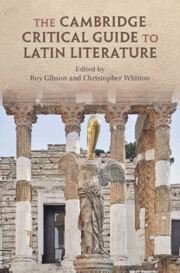Book contents
- The Cambridge Critical Guide to Latin Literature
- The Cambridge Critical Guide to Latin Literature
- Copyright page
- Dedication
- Contents
- Figures and Tables
- Contributors
- Preface
- Abbreviations
- Chapter 1 Introduction
- Chapter 2 Canons
- Chapter 3 Periodisations
- Chapter 4 Author and Identity
- Chapter 5 Intertextuality
- Chapter 6 Mediaeval Latin
- Chapter 7 Neo-Latin
- Chapter 8 Reception
- Chapter 9 National Traditions
- Chapter 10 Editing
- Chapter 11 Latin Literature and Linguistics
- Chapter 12 Latin Literature and Material Culture
- Chapter 13 Philosophy
- Chapter 14 Political Thought
- Chapter 15 Latin Literature and Roman History
- Chapter 16 Latin Literature and Greek
- Envoi
- Index Locorum
- General Index
- References
Chapter 12 - Latin Literature and Material Culture
Published online by Cambridge University Press: 04 January 2024
- The Cambridge Critical Guide to Latin Literature
- The Cambridge Critical Guide to Latin Literature
- Copyright page
- Dedication
- Contents
- Figures and Tables
- Contributors
- Preface
- Abbreviations
- Chapter 1 Introduction
- Chapter 2 Canons
- Chapter 3 Periodisations
- Chapter 4 Author and Identity
- Chapter 5 Intertextuality
- Chapter 6 Mediaeval Latin
- Chapter 7 Neo-Latin
- Chapter 8 Reception
- Chapter 9 National Traditions
- Chapter 10 Editing
- Chapter 11 Latin Literature and Linguistics
- Chapter 12 Latin Literature and Material Culture
- Chapter 13 Philosophy
- Chapter 14 Political Thought
- Chapter 15 Latin Literature and Roman History
- Chapter 16 Latin Literature and Greek
- Envoi
- Index Locorum
- General Index
- References
Summary
This chapter introduces the rich intersections between Latin literature and Roman material culture. Why should Latin scholars concern themselves with ancient objects? How might study of Roman physical remains inform an understanding of Latin literature? In what ways do attitudes towards Roman material remains align with disciplinary approaches to interpreting Latin literature? The chapter proceeds in seven interconnected parts. The first examines the materiality of Roman texts, introducing the picture-poems of Optatian. This leads to cultural ideas about words and images – and not least to the artefactual nature of manuscripts in both roll and codex. Late-antique ‘illustrated’ manuscripts take us to the rhetorical phenomenon of ‘ecphrasis’. Ecphrasis has been much discussed in recent years; but there remains a reluctance to look across the landscapes of art and text: a residual blindness to the ‘cyclical’ dynamics between visual and verbal media. The point leads to an analysis of words and images displayed in a shared environment, as well as some of the Roman rhetorical conceptual underpinnings. It also leads, in the final section, to variables of education, learning and literacy.
Keywords
- Type
- Chapter
- Information
- The Cambridge Critical Guide to Latin Literature , pp. 613 - 699Publisher: Cambridge University PressPrint publication year: 2024
References
- 1
- Cited by



